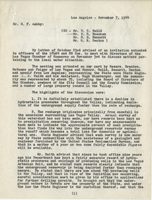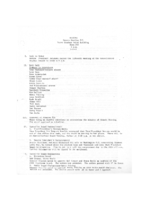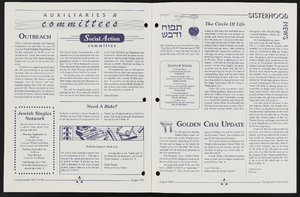Search the Special Collections and Archives Portal
Search Results

Meeting minutes for Consolidated Student Senate University of Nevada, Las Vegas, May 14, 1999
Date
Archival Collection
Description
Text

Transcript of interview with Jonathan Sparer by Stefani Evans and Claytee White, August 29, 2016
Date
Archival Collection
Description
Text

Transcript of interview with Charlie Lombardo by David G. Schwartz, June 28, 2016
Date
Archival Collection
Description
Text

Letter from Frank Strong (Los Angeles) to G. F. Ashby, November 7, 1944
Date
Archival Collection
Description
Meeting on water in Las Vegas. Discussion included the decline in water pressure throughout the valley, watershed recharge, BMI Water, a possible water district, well drilling, and more.
Text

Meeting minutes for Consolidated Student Senate, University of Nevada, Las Vegas, March 02, 1982
Date
Archival Collection
Description
Text
Alice Key Papers
Identifier
Abstract
The Alice Key Papers (1936-2004) consist of documents detailing Alice Key’s life and work in the African American community, historic preservation, and labor relations in Las Vegas, Nevada. Included in the collection are awards and certificates documenting Key’s achievements, invitations and programs to events, political and civic correspondence, and magazine and newspaper articles both about Key and written by her. The collection also contains photographs.
Archival Collection

Transcript of interview with Rabbi Mel Hecht by Barbara Tabach, March 17, 2016
Date
Archival Collection
Description
In this interview, Hecht talks his life experiences leading him to becoming a rabbi, eventually being a spiritual leader in Las Vegas. He discusses his experiences at Ner Tamid as well as the joy of starting Temple Beth Am, with the support of Morris and Lillian Shenker. Hecht shares stories about working with unions and Ralph Engelstad.
In 1939, Rabbi Mel Hecht was born in Detroit, Michigan. At the age of five, his family moved to Miami, Florida where they had a large, extended Jewish family, complete with relatives who were hazzans and mohels. Soon after moving to Florida, his parents bought a hotel in Hialeah, about 10 miles outside of the city, where Hecht spent the remainder of his childhood. Hecht attended the University of Miami where he earned a Ph.D. in Divinity, and subsequently attended the Hebrew University of Jerusalem. In 1971, he became a rabbi upon graduating from seminary in Cincinnati, Ohio. Three years later, Hecht joined the U.S. Army and served as a race relations officer in Germany. After his service, Hecht returned to Florida (Fort Pierce) to lead his own congregation, and in 1980, he moved to Las Vegas and became the congregational rabbi for Congregation Ner Tamid. Two years later, he left Ner Tamid to start a new congregation?Temple Beth Am?which grew swiftly. In 1982, Hecht also married Michelle (?Micki?). The couple have three children: Melissa Hecht, Karin Toti, and Adam Hecht.
Text

Meeting minutes for Consolidated Student Senate, University of Nevada, Las Vegas, April 26, 2004
Date
Archival Collection
Description
Text


